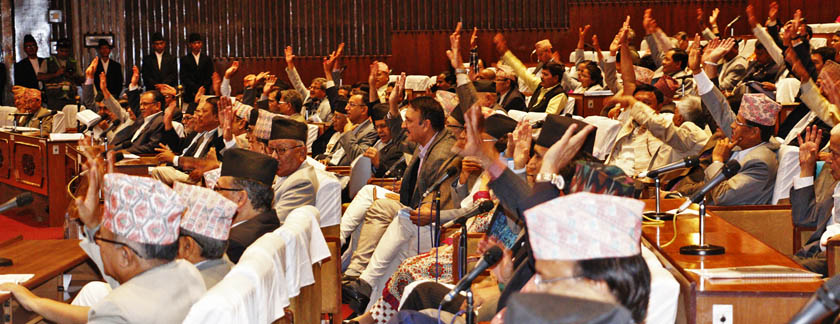176 articles endorsed in three days
Kathmandu, September 15
The Constituent Assembly has endorsed 176 articles since the voting on the final bill of the new constitution began on Sunday.
The CA has endorsed the provisions from the amendment proposal jointly registered by three major parties – Nepali Congress, CPN-UML and Unified CPN-Maoist – and rejected proposals registered by others.
Although the Unified CPN-Maoist and CPN-UML were for directly-elected chief executive, both the parties voted against it and endorsed Parliament-elected prime minister as chief executive.
Big III also endorsed bicameral federal Parliament, having 275-member House of Representatives with a tenure of five years (165 members elected through the-First-Past-the-Post system and 110 through the Proportional Representation system) and 59-member National Assembly. The provisions related to the list of rights and duties of federal Parliament was also passed with two-thirds majority.
Although the provisions related to President and vice-president, who will be elected for five years from an electoral college comprising members of the Parliament and provincial assemblies, was endorsed, fringe parties’ proposal to add bachelor’s or master’s degree as minimum educational qualification for holding the posts of President and vice-president was rejected.
The amendment proposal of the three parties to replace the provision of Constitutional Court by a constitutional bench in the Supreme Court to look into the disputes between and among centre, federal units and local bodies was also okayed.
Another joint amendment proposal of the three parties requiring Supreme Court to have 21 justices, including chief justice, was also passed.
Voting process will resume at 10:30am tomorrow. There are 302 articles and nine schedules in the proposed constitution.
What was rejected
- Directly-elected executive president
- Directly-elected executive prime minister
- Appointment of ministers from outside the Parliament
- Multi-Member Proportional Representation election system for electing members of House of Representatives
- Provision of people’s right to recall MPs to replace them
- Determining election constituencies on the basis of population only
- Reserving at least 40 FPTP seats for women
- Appointment of judges/justices on the basis of proportional inclusion
- A separate Constitutional Court
- Provincial Court instead of High Court
- Minimum educational qualification of President, vice-president and prime minister and heads of provinces
What got accepted
- Determination of election constituencies on the basis of population and geography
- 21 justices for Supreme Court, including chief justice
- Constitutional bench in Supreme Court to look into the disputes between and among centre, provinces and local bodies
- High Court in each province






